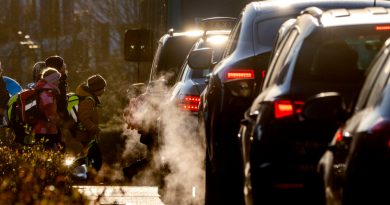China battles biggest surge in Covid cases since original Wuhan outbreak
ShanghaiChina’s financial hub of Shanghai reported on Monday a record daily surge in local Covid-19 infections as authorities scrambled to test residents and rein in the Omicron variant, while closing its Disney (DIS) resort until further notice.
Until recent weeks relatively unscathed by coronavirus, Shanghai reported 24 new domestically transmitted Covid cases with confirmed symptoms for Sunday and 734 local asymptomatic infections, official data showed on Monday. It is the fourth consecutive day that Shanghai’s local asymptomatic infections have increased.
Although the tally of infections is tiny by global standards, Shanghai has quickly followed China’s “dynamic clearance” policies, shutting schools and testing residential compounds in the effort to limit the spread of the virus.
“When it comes to the entire situation of epidemic control and prevention that we are facing, it is very complex and serious, and it is also a very big test for us,” city health official Wu Jinglei told a news briefing. Shanghai will stick with “dynamic clearance,” Wu added, saying he hoped for continued public support for the policy.
The city also shut the Shanghai Disney Resort from Monday until further notice.
“Due to the current pandemic situation, Shanghai Disney Resort, including Shanghai Disneyland, Disneytown and Wishing Star Park will be temporarily closed from Monday, March 21, 2022,” the resort said in a statement on its website.
“We will continue to monitor the pandemic situation and consult local authorities, and will notify guests as soon as we have a confirmed date to resume operations,” it added.
But there were signs of frustration with the city’s ad hoc, district-by-district approach.
“Hong Kong, Shanghai and Shenzhen have had three different epidemic response models,” said a user of China’s Twitter-like Weibo network.
“Hong Kong is the worst but will be the first to open up,” the writer, going by the name zangyn, said in a widely shared post. “Shenzhen is the most effective, and Shanghai may be the most tiring, and even the most miserable.”
The severity of outbreak responses by Shanghai’s compounds and residential districts varied, with some opting for lockdowns as long as two weeks. Some people in other sealed-off districts said they were not told how long they would have to stay home.
Residents’ committees helping to organize testing programs also encountered challenges. One compound distributed tokens to foil outsiders’ attempts to take free tests.
Including Shanghai infections, mainland China reported a total of 1,947 new locally transmitted cases with confirmed symptoms on Sunday, data from the National Health Commission (NHC) showed, up from 1,656 a day earlier.
JUST WATCHED
Thousands stuck at Shanghai Disneyland after one Covid case nearby was reported. See what it looked like
MUST WATCH
The top steelmaking city of Tangshan, with just 12 local infections since March. 19, is allowing only essential vehicles on roads smaller than expressways, while people with special needs who must use vehicles have to seek approval.
The southern manufacturing hub of Shenzhen has allowed work and production activities, as well as bus and subway services in most areas, to resume after daily local case numbers dropped following three rounds of city-wide testing.
Tight curbs remain in some places, however.
Shenzhen residents still need to show negative tests in order to use public transport from Monday until March 27, a period in which non-essential indoor services will stay closed, the city government has said.
Vaccine candidates to target Omicron specifically, or among variants of concern, are in studies prior to clinical trials, a national health official said on Saturday, without identifying the companies involved.
China’s new local asymptomatic cases, which it does not classify as confirmed cases, was 2,384, up from 2,177 a day earlier. The death toll was unchanged at 4,638, with no new deaths.
By Sunday, mainland China had reported 132,226 cases with confirmed symptoms, both among locals and arrivals from outside.
Source: Read Full Article






